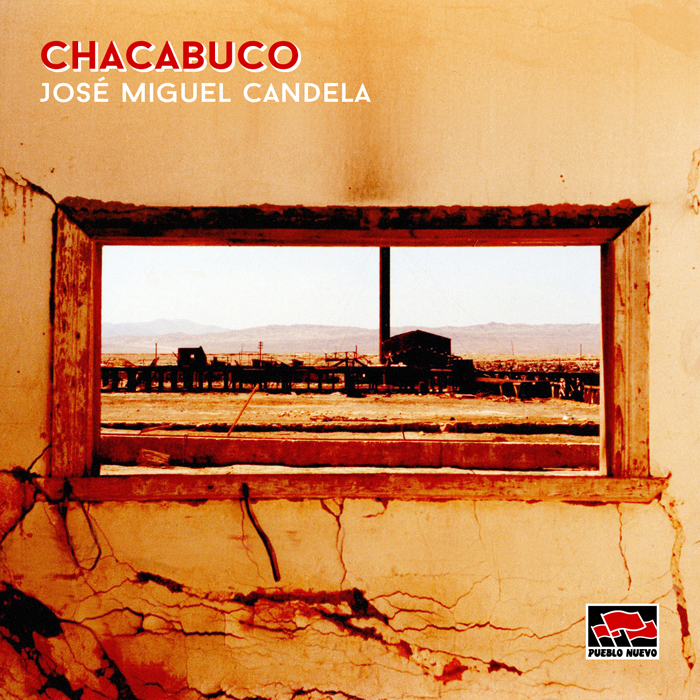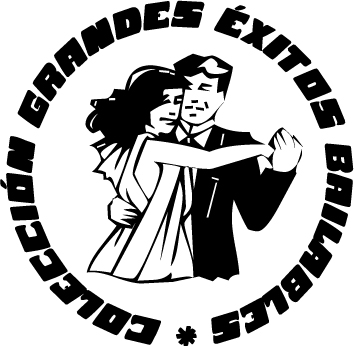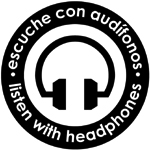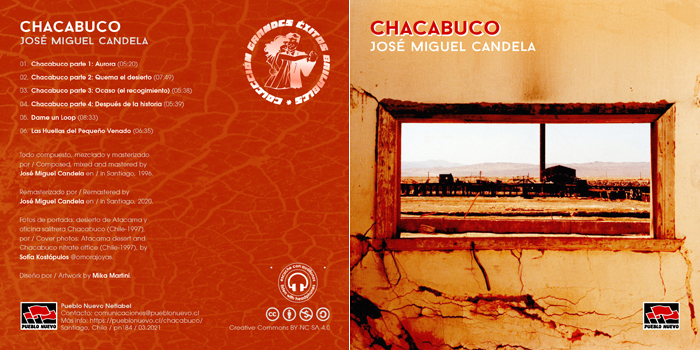[pn184] Chacabuco 2021
by José Miguel Candela [Chile]

Track list
Inaugurando la “Colección Grandes Éxitos Bailables”, Pueblo Nuevo Netlabel se complace en presentar la reedición remasterizada del disco “Chacabuco”, del compositor electroacústico chileno José Miguel Candela.
Inaugurating the “Greatest Dance Hits Collection”, Pueblo Nuevo Netlabel is pleased to present the remastered reedition of the album “Chacabuco”, by Chilean electroacoustic composer José Miguel Candela.
PRESENTACIÓN / OVERVIEW:
La primera edición de “Chacabuco” (en formato cassette) fue en el año 1996. En esta se reunía la música compuesta para la coreografía y video-danza* homónimos de la Compañía de danza La Vitrina (Chile), donde se rescataba la experiencia de los cuerpos que sufrieron la salitrera Chacabuco como cárcel económica (en tiempos del auge del salitre) y como campo de concentración (en la dictadura de Pinochet en Chile). Esta no sólo fue mi primera de muchas colaboraciones con este colectivo artístico, sino que además fue mi primera composición para danza contemporánea, campo artístico al cual he dedicado mi vida musical desde entonces. Hoy, a 25 años de su composición y edición, presento nuevamente esta música, remasterizada para su formato en disco virtual, de manera de poder así compartir este pedacito de historia con las nuevas generaciones.
Con este disco, también inauguramos, siempre con el incondicional apoyo de Pueblo Nuevo Netlabel, la “Colección Grandes Éxitos Bailables”. Esta serie de publicaciones intentará compilar la música que he compuesto para danza contemporánea durante estos últimos 25 años.
Todo el trabajo fue compuesto, secuenciado y mezclado en la estación de trabajo Ensoniq TS-12. Gran parte de los sonidos de “Chacabuco” fueron grabados directamente en la salitrera, y luego sampleados para su uso en esta estación de trabajo.
En el texto del cassette original de 1996, señalaba lo siguiente:
El estar en Chacabuco no es una experiencia que se olvide fácilmente: toda esa fuerza contenida en cada una de sus máquinas (cachuchos), en sus calles y casas destruidas de sonidos sordos, en su tierra (crujiente por el salitre), y en su viento vespertino (gran agitador de techumbres desclavadas) deja una marca, una huella invisible (pero poderosa), en los más últimos rincones emocionales de quien la visita. Espero que estas impresiones tan intangibles queden de alguna manera reflejadas en esta composición.
El lenguaje resultante de “Chacabuco” no habría sido posible sin mi previo “Dame un Loop”, proyecto personal que nace en mayo de 1996. “Dame un Loop” refleja mi búsqueda de ritmos corporales íntimos (búsqueda de un rito corporal), y por lo tanto de un lenguaje musical acorde con esta búsqueda. Desde otro punto de vista, se encuentra el loop (el ciclo repetitivo y en este caso, el micro-ciclo) como vida independiente; en su movimiento espacial, y a la vez atrapado en sus limitaciones; liberándose a través de la repetición, pero extinguiéndose para dar paso a nuevos ciclos.
Por último, “Las huellas del Pequeño Venado” (terminado en diciembre de 1996), se inserta también dentro de este lenguaje. Los chamanes huicholes, en uno de sus ritos sagrados, logran ver estas huellas del pequeño venado (animal mágico), el que los conducirá al primer peyote. Por lo mismo, es el inicio del viaje a lo desconocido.
(*) “Chacabuco – eslabón en la memoria” es el primer video-danza de la historia del género en Chile.
The first edition of “Chacabuco” (in cassette format) was in 1996. In this the music composed for the choreography and video-dance * homonyms of the La Vitrina dance company (Chile), where the experience was rescued of the bodies that suffered the Chacabuco saltpeter mine works as an economic prison (in times of the nitrate boom) and as a concentration camp (during the Pinochet dictatorship in Chile). This music was not only my first of many collaborations with this artistic collective, but it was also my first composition for contemporary dance, an artistic field to which I have dedicated my musical life ever since. Today, 25 years after its composition and editing, I present this music again, remastered for its virtual disk format, to share this piece of history with new generations.
With this album, we also inaugurated, always with Pueblo Nuevo Netlabel‘s unconditional support, the “Greatest Dance Hits Collection”. This series of publications will attempt to compile the music that I have composed for contemporary dance during the last 25 years.
All work was composed, sequenced, and mixed on the Ensoniq TS-12 workstation. Much of the sounds of “Chacabuco” were recorded directly there and then sampled for use in this workstation.
In the text of the original 1996 cassette, it noted the following:
Being in Chacabuco is not an experience that is easily forgotten: all that strength contained in each of its machines (“cachuchos”), in its streets and houses destroyed by deaf sounds, in its land (crunchy by the saltpeter), and in its evening wind (a great shaker of unclamped roofs) leaves a mark, an invisible (but powerful) mark, in the last emotional corners of those who visit it. I hope that these intangible impressions are somehow reflected in this composition.
The resulting language of “Chacabuco” would not have been possible without my previous “Give me a Loop”, a personal project born in May 1996. “Give me a Loop” reflects my search for intimate corporal rhythms (search for a corporal ritual), and therefore of a musical language according to this search. From another point of view, the loop (the repetitive cycle and in this case, the micro-cycle) is found as an independent life; in its spatial movement, and at the same time trapped in its limitations; releasing itself through repetition, but dying out to make way for new cycles.
Finally, “Las huellas del Pequeño Venado” (“The Little Deer Traces”) (completed in December 1996), is also inserted within this language. The Huichol shamans, in one of their sacred rites, manage to see these footprints of the little deer (magical animal), the one that will lead them to the first peyote. For this reason, it is the beginning of the journey to the unknown.
(*) “Chacabuco – eslabón en la memoria” is the first video-dance in the history of the genre in Chile.
José Miguel Candela
(Santiago, Chile. Marzo / March 2021)
Agradecimientos / Thanks to:
A Pueblo Nuevo Netlabel, por su constante e inclaudicable apoyo a la difusión de la música electroacústica chilena / To Pueblo Nuevo Netlabel, for its constant and unwavering support for the diffusion of Chilean electroacoustic music.


Colección Grandes Éxitos Bailables. Se recomienda su escucha con audífonos
Greatest Dance Hits Collection. Listen with headphone recommended.
Track List:
01. Chacabuco parte 1: Aurora (05:20)
02. Chacabuco parte 2: Quema el desierto (07:49)
03. Chacabuco parte 3: Ocaso (el recogimiento) (05:38)
04. Chacabuco parte 4: Después de la historia (05:39)
05. Dame un Loop (08:33)
06. Las Huellas del Pequeño Venado (06:35)
Tiempo total / total play: 39:34
Estilo / Genre:
Acousmatic | Electroacoustic | Minimal
BAJA GRATIS EN MP3/FLAC DESDE / FREE DOWNLOAD MP3/FLAC:
https://pueblonuevo.cl/chacabuco/
https://archive.org/details/pn184
Escúchalo en Spotify / Listen on Spotify:
https://open.spotify.com/album/1YbU2i3YuBLymdipnv2utu
INFORMACIÓN DEL DISCO / RELEASE INFO:
Release “Chacabuco” [pn184], 03.2021.
Copyright: Licenciado para el público bajo Creative Commons:
Reconocimiento – No Comercial – Compartir igual – 3.0
http://creativecommons.org/licenses/by-nc-sa/3.0/
Créditos / Credits:
Todo compuesto, mezclado y masterizado por / Composed, mixed and mastered by José Miguel Candela en / in Santiago, 1996.
Remasterizado por / Remastered by José Miguel Candela en / in Santiago, 2021.
Fotos de portada: desierto de Atacama y oficina salitrera Chacabuco (Chile-1997), por / Cover photos: Atacama desert and Chacabuco nitrate office (Chile-1997), by Sofía Kostópulos @omorajoyas.
Diseño por / Artwork by Mika Martini.
 Otros comentarios + artículos + reseñas / Other comments + articles + reviews Otros comentarios + artículos + reseñas / Other comments + articles + reviews |
||
| 26.03.2021 | online review | www.clongclongmoo.org |
